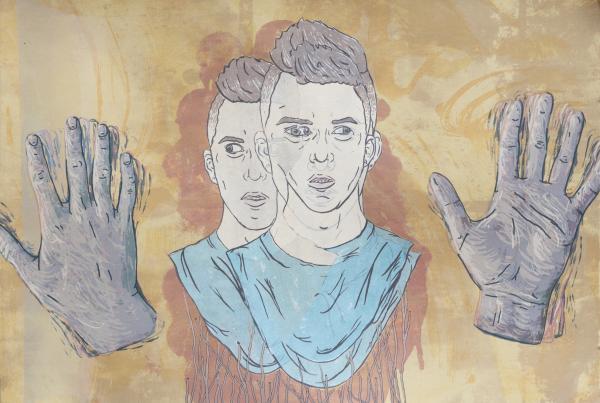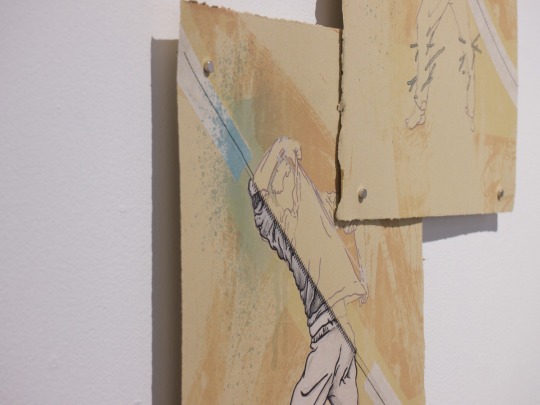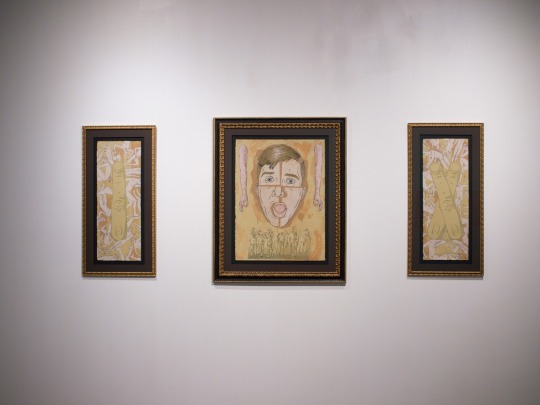Kale Vandenbroek | Autospect
July 28–September 9, 2017
Opening reception for members & guests: Friday, July 28 at 7 pm
One-on-One exhibition tours with the artist | Saturday, July 29
Calgary artist Kale Vandenbroek peers into the self, hypercritical of every movement and thought in this collection of print and mixed-media works. Pasting an image down and wearing it away, his paint-like surfaces suggest imprecise narratives of introspection and a cast of personalities in extended techniques grounded in the traditions of printmaking and illustration.
Autospect by Calgary-artist Kale Vandenbroek is up at Latitude 53 until September 9. Brad Fehr, an Edmonton-based artist, and recent graduate of UofA fine arts program takes a close look at self-reflection, suspicion and masculinity found in Autospect.
There is a sense of the cryptic in Autospect. More than just the feeling of tip-toeing in the annals of another person, the blend of identity and narrative transcends the artist’s own inquisition and touches something broader.
On a slender black table in the centre of the room, the artist has placed a series of silkscreen prints which adopt the language of Tarot. In lieu of wands and cups Vandenbroek uses fingers and teeth. And each ornate black and bronze frame which hangs from the wall around this table imbues the chill of Cartesian doubt. When Descartes abandoned all knowledge in which he could find reason to doubt, he landed on the Self as the bedrock from which to rebuild. These days we know it isn’t so easy. The Self is sour ground, shaped and cultivated before we had control of it. The question of identity is a poisonous one, even as we try to extract poison from ourselves.
This auto-suspicion yields inner conflict, self-deprecation, a criticism which leads to “periods of great self-doubt,” in the artist’s words. How could an ethical identity today yield anything else? Doubt and context overwhelm the artist’s illustration, make him both the witness of a story and the medium in which it is told. On rag paper the backgrounds hint at figures and shapes that never coalesce beyond ambiance. On canvas they glitter even as they are stained with brown drips, seeming like old wallpaper on a sweating wall. The resulting space they create could be either mind or story, but in either case it is the site of the Self. Out of this ambiguity, as if summoned by it, the artist’s illustration recurs in parts and in whole. The same head may appear across multiple pieces, made different only by the context, or the same arm appear four times in a single print. Vandenbroek utilizes printmaking’s ability for recreating an image. His illustration takes the form of a living stencil broken apart and re-made to suit the needs of the scene in which it occurs. Even to construct a face, such as in “The Lie of Saccadic Masking” or “The Thought of Return,” the artist uses pieces which seem whole at quick glances. They are unable to withstand solid scrutiny.
Perhaps the Self is grasped only in moments and habits, the repetition which defines behaviour. As each print is stitched and taped together perhaps the individual, too, is defined less from the finished whole and more from the unending process of temporary solutions to instability. The stitches fray and the tape loses itself under colours and surfaces until one isn’t sure which is holding what.
Past all of this introspection there is yet the question of the external world. Every instance of another person in memory, and indeed in Vandenbroek’s prints, is just another part of oneself, a figment of the mind we make after the experience. There is a loneliness behind the veil of perception. It is perhaps like John Locke suggested, that the external world is forever cordoned off from us, that all of our ideas of the outside are just that—ideas we’ve made ourselves. And perhaps this is the source of Autospect’s cryptic flow: we are not in the annals, but behind the veil of another.
Yet if the external world prompts ideas in us, we cannot ignore how we prompt the external world back. This is, I suppose, the crux of contemporary masculinity. Autospect is replete with masculine imagery—outside of the traditionally masculine body, phalluses and hints of violence abound. One gets a stunning whiff of it in certain moments, such as in “Holding Back” which stands in such stillness it’s hard to look away from. Can one resist a society which demands and deifies a specific masculinity while, at the same time, possessing elements of that very same essence? Looking closely at “Root Issue Number One,” we see more than ambiguous shapes in the background of the image. Flanking a set of subtle gold scales held by the fingertips of the artist’s illustration we see a phrase bubble up from the haze: “Don’t forget this.”
-
Brad Fehr is an Edmonton-based artist whose work explores the facets and implications of masculinity in the contemporary era as well as the historical construction of manhood in pop culture. His work has appeared in print within As.iZ Magazine, in public venues across Edmonton during YEGCanvas 2016, and more recently in group shows at the Scott Gallery, FAB Gallery, and Latitude 53.
He is active through his website and Instagram





